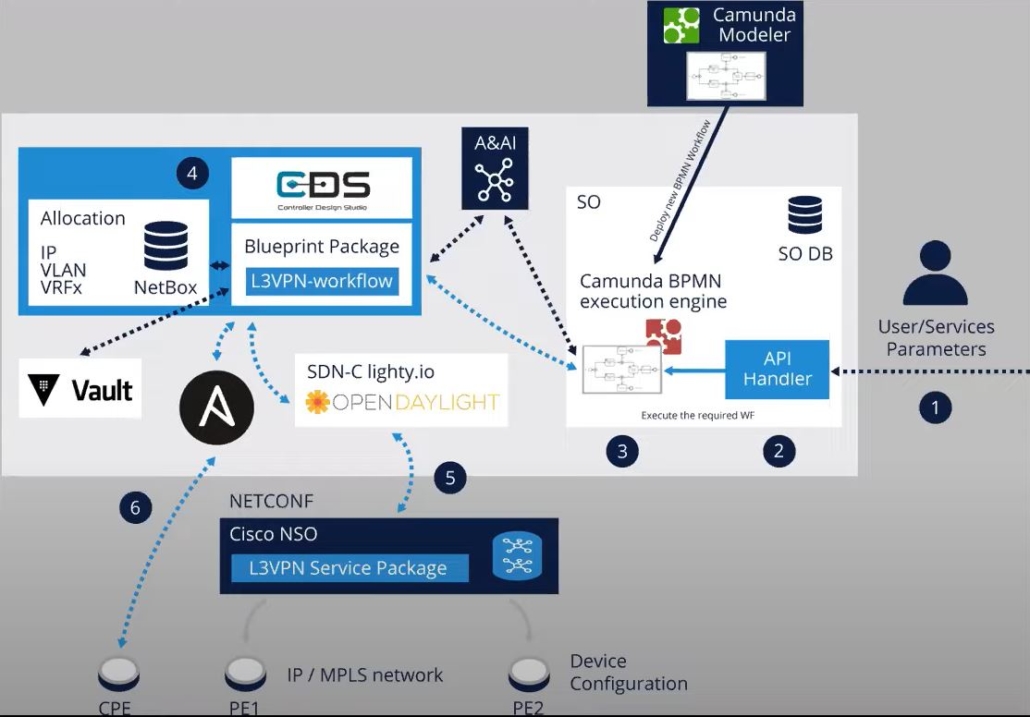On the 11th of November, Orange hosted a webinar with The Linux Foundation, showcasing their production deployment of ONAP to automate their IP/MPLS transport network infrastructure.
Learn how to containerize and deploy your own lighty.io RNC instance in this tutorial!
https://pantheon.tech/containerized-lightyio-rnc/
PANTHEON.tech is extremely proud to see their OpenDaylight based lighty.io project, included in this, Orange’s first, successful production ONAP deployment. lighty.io is an open-source project developed and supported by PANTHEON.tech.
Open-Source Matters
Orange’s vision and target are to move from a closed IT architecture to an open platform architecture based on the Open Digital Framework, a blueprint produced by members of TMForum. ONAP provides ODP compliant functional blocks to cover the delivery of many use-cases like service provisioning of 5G transport, IP, fixed access, microwave, optical networks services, as well as CPE management, OS upgrades, and many others.
Why lighty.io?
The SDN-C is the network controller component of ONAP – managing, assigning, and provisioning network resources. It is based on OpenDaylight, with additional Directed Graph Execution capabilities. However, lighty.io, PANTHEON.tech’s enhanced OpenDaylight based software, offers significant benefits in performance, agility, and availability, taking SDN-C to another level.
OpenDaylight vs. lighty.io
As the ongoing lead contributor to Linux Foundation’s OpenDaylight, PANTHEON.tech develops lighty.io, with the ultimate goal of enhancing the network controller experience for a variety of use-cases.
With increased functionality to upgrade dependencies and packaged use-case-based applications, lighty.io brings Software-Defined Networking to a Cloud-Native environment.
lighty.io offers a modular and scalable architecture, allowing dev-ops greater flexibility to deploy only those modules and libraries that are required for each use-case. This means that lighty.io is not only more lightweight at run time, but also more agile at development and deployment time.
And since only the minimum required set of components and libraries is present in a deployment at runtime, stability is enhanced as well.
Due to its modular capability, lighty.io provides a stable & scalable network controller experience, ideal for production deployments, enabling the burgeoning multitude of 5G/Edge use cases.
A reduced codebase footprint and packaging makes lighty.io more:
- Lightweight
- Agile
- Stable
- Secure
- Scalable
PANTHEON.tech also provides other complementary tools, plugins, and additional features, like:
- Java Protocol libraries
- Network Simulators
- YANG Validators
- Pre-packaged, container use-case driven application, with Helm charts
Orange Egypt: ONAP Production Deployment
Orange Egypt uses ONAP as a northbound, higher-level orchestration, for L3VPN service provisioning.
The user leverages a GUI to enter network service parameters. The request is then submitted to the ONAP Service Orchestrator (SO), powered by Camunda‘s BPMN workflow engine, through a REST API and custom-designed workflow is executed.
Afterward, an instantiated ONAP SO workflow triggers the ONAP Controller Design Studio (CDS) using a REST API to run custom blueprint packages to start the provisioning of L3VPN network services.
In this production deployment, lighty.io is used for communication between CDS and Cisco NSO. The application used in the ONAP production deployment is lighty-RNC – a pre-packaged container image, providing a RESTCONF-NETCONF bridge.
CDS assigns required resources (IP + VLAN) from NETBOX and lighty.io secret from Vault. After successful allocation of needed resources by CDS, lighty.io then sends the information to Cisco NSO to configure devices via a NETCONF session.

Source: YouTube, LFN Webinar: Orange Deploys ONAP In Production
Future of ONAP
Orange demonstrated ONAP in an IP/MPLS backbone automation use-case, but that is just the beginning. ONAP is already starting to look into automation and SDN control of microwave and optical networks, paving the way for other operators to deploy ONAP in their use cases.
You can watch the entire webinar here:
by PANTHEON.tech | Leave us your feedback on this post!
You can contact us here!
Explore our PANTHEON.tech GitHub.
Watch our YouTube Channel.



![[Release] OpenDaylight Titanium](https://pantheontech1.b-cdn.net/wp-content/uploads/2025/08/odl-titanium-release.png)
![[Meet Us] PANTHEON.tech @ Open Source Summit 2025 in Amsterdam](https://pantheontech1.b-cdn.net/wp-content/uploads/2025/08/OSS_Temp.png)
![[What Is] LAG & MLAG](https://pantheontech1.b-cdn.net/wp-content/uploads/2025/08/lag-mlag-thumb.png)